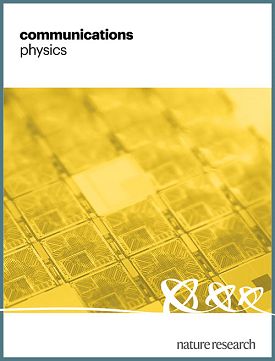硅探测器中相对论粒子的集体激发和低能电离特征
IF 5.8
1区 物理与天体物理
Q1 PHYSICS, MULTIDISCIPLINARY
引用次数: 0
摘要
具有低能量阈值的固态探测器有几种应用,包括搜索质量低于gev的非相对论性晕暗物质粒子。当寻找相对的、超越标准模型的、具有增强截面的小能量转移粒子时,具有低能量阈值的小型探测器可能比具有较高能量阈值的大型探测器具有更好的灵敏度。本文计算了高速粒子在介质中散射的低能电离谱。我们考虑了包括体等离子激元激发在内的全材料响应。我们将能量损失函数推广到相对论运动学中,并根据电子能量损失谱数据对晕状暗物质散射的现有工具进行了基准测试。与文献中常用的计算方法(如光吸收-电离模型或自由电子模型)相比,包括集体效应在内的计算方法将反冲电离谱向高能量方向移动,通常在4-6个电子-空穴对左右达到峰值。我们将结果应用于三个基准例子:在束流中产生的带电粒子,在反应堆中产生的具有磁偶极矩的中微子,以及向上散射的暗物质粒子。我们的结果表明,适当地包含集体效应通常会提高探测器对这些粒子的灵敏度,因为探测器背景,如暗计数,在较低的能量下达到峰值。作者计算了从硅探测器散射的相对论性弱相互作用粒子的低能激发截面。这使得使用SENSEI探测器收集的数据搜索带电粒子成为可能,并为低阈值半导体探测器的应用开辟了一条新的道路,以搜索新的物理。本文章由计算机程序翻译,如有差异,请以英文原文为准。

Collective excitations and low-energy ionization signatures of relativistic particles in silicon detectors
Solid-state detectors with a low energy threshold have several applications, including searches of non-relativistic halo dark-matter particles with sub-GeV masses. When searching for relativistic, beyond-the-Standard-Model particles with enhanced cross sections for small energy transfers, a small detector with a low energy threshold may have better sensitivity than a larger detector with a higher energy threshold. In this paper, we calculate the low-energy ionization spectrum from high-velocity particles scattering in a dielectric material. We consider the full material response including the excitation of bulk plasmons. We generalize the energy-loss function to relativistic kinematics, and benchmark existing tools used for halo dark-matter scattering against electron energy-loss spectroscopy data. Compared to calculations commonly used in the literature, such as the Photo-Absorption-Ionization model or the free-electron model, including collective effects shifts the recoil ionization spectrum towards higher energies, typically peaking around 4–6 electron-hole pairs. We apply our results to the three benchmark examples: millicharged particles produced in a beam, neutrinos with a magnetic dipole moment produced in a reactor, and upscattered dark-matter particles. Our results show that the proper inclusion of collective effects typically enhances a detector’s sensitivity to these particles, since detector backgrounds, such as dark counts, peak at lower energies. The authors calculate the low-energy excitation cross section for relativistic feebly interacting particles scattering from silicon detectors. This enables a search for millicharged particles using data collected by the SENSEI detector and opens a new path for applications of low-threshold semi-conductor detectors to search for new physics.
求助全文
通过发布文献求助,成功后即可免费获取论文全文。
去求助
来源期刊

Communications Physics
Physics and Astronomy-General Physics and Astronomy
CiteScore
8.40
自引率
3.60%
发文量
276
审稿时长
13 weeks
期刊介绍:
Communications Physics is an open access journal from Nature Research publishing high-quality research, reviews and commentary in all areas of the physical sciences. Research papers published by the journal represent significant advances bringing new insight to a specialized area of research in physics. We also aim to provide a community forum for issues of importance to all physicists, regardless of sub-discipline.
The scope of the journal covers all areas of experimental, applied, fundamental, and interdisciplinary physical sciences. Primary research published in Communications Physics includes novel experimental results, new techniques or computational methods that may influence the work of others in the sub-discipline. We also consider submissions from adjacent research fields where the central advance of the study is of interest to physicists, for example material sciences, physical chemistry and technologies.
 求助内容:
求助内容: 应助结果提醒方式:
应助结果提醒方式:


